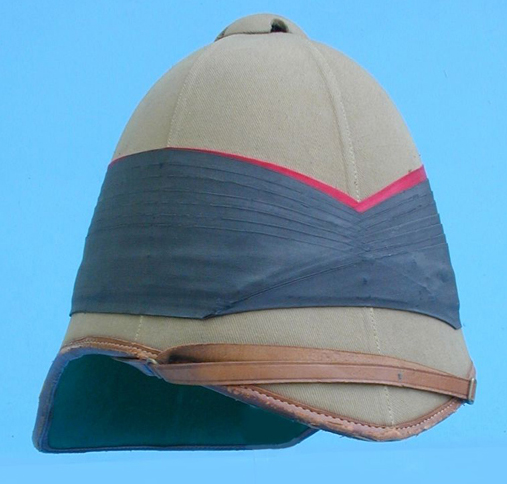
This Colonial Pattern helmet, of the 49th Ottawa-Carleton Rifles, illustrates the most common form of the puggaree with two folds: front and rear. (Collection of Clive M. Law)
The puggaree (or pagri, pugri etc.) was an addition to the headgear of the British soldier primarily being for protection against sword cuts but also protection from the heat of the sun. Just how effective it was in this latter use is debatable. In its many forms it was also a decorative item and was additionally used to distinguish regiments and corps. The cloth wrapped around the crown of the helmet was most commonly folded over in two places: at the front and the rear. However, examples of the puggaree being folded in three, four and six positions are known to have existed. In this article the six seams of the helmet cover are equated to positions on a clock face with 12 o’clock being the rear seam and 6 o’clock being the front seam etc.
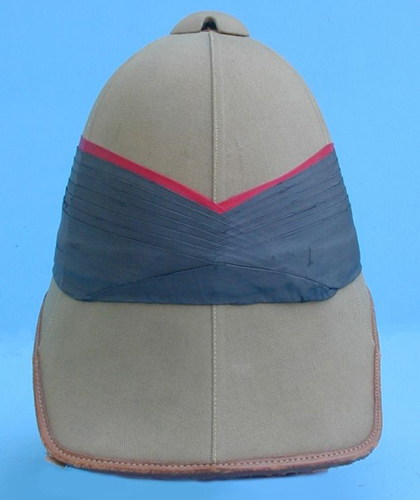
The rear of the 49th Ottawa-Carleton Rifles shows the second fold of the puggaree. (Collection of Clive M. Law)
The following extract from the diary of Lieutenant Richard Barter, Adjutant of the 75th Foot, illustrates the primary intention of the puggaree:
“In the evening the order was published for the storming of Delhi a little before daybreak the next morning, September 14, and we each of us looked carefully to the reloading of our pistols, filling of flasks, and getting as good protection as possible for our heads, which would be exposed so much going up the ladders. I wound two puggris or turbans round my old forage cap, with the last letter from the hills [Mrs. Barter was then at Kasauli, in the Himalayas] in the top, and committed myself to the care of Providence.” 1
And from Lieutenant Edward Joseph Thackwell, 3rd (The King’s Own) Regiment of Light Dragoons, who was present at the battles of Chillianwallah and Goojerat, and the action at Sodoolspore:
“The propensity of the Seikhs to aim their cuts at the back of the head, was so unequivocally manifested on the 22nd November, that it became an object of consideration to the officers of the army to provide some defence, however slight, for the precious caput. Some officers wrapped rolls of linen cloth round the back of the shako, the folds of which hung down over the back of the shako, affording some protection.” 2
Three Fold Puggarees
The Suffolk Regiment
This regiment had three folds to its puggaree: two on each side and one at the rear. The folds were aligned to the 12, 4 and 8 o’clock seams in the helmet cover. The red and yellow piping was adopted in 1928. 3
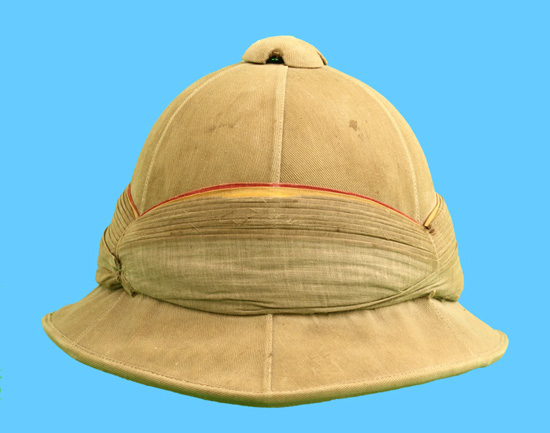
This front-on photo of a Wolseley helmet to the Suffolk Regiment shows the two folds at the side of the helmet aligned with the 4 and 8 o’clock seams. (Author’s collection)
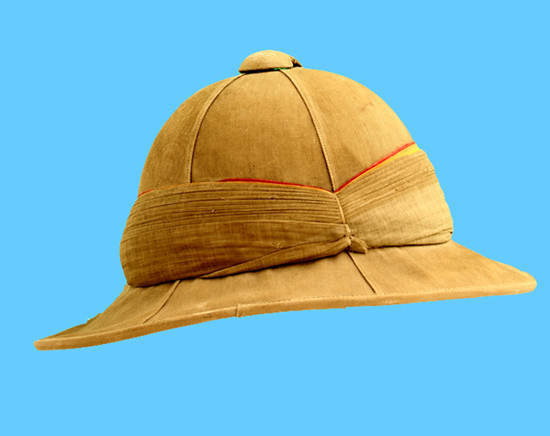
This side-on photo of the Suffolk’s Wolseley clearly shows the position of the side fold on the right side and aligned on the 8 o’clock seam. (Author’s collection)
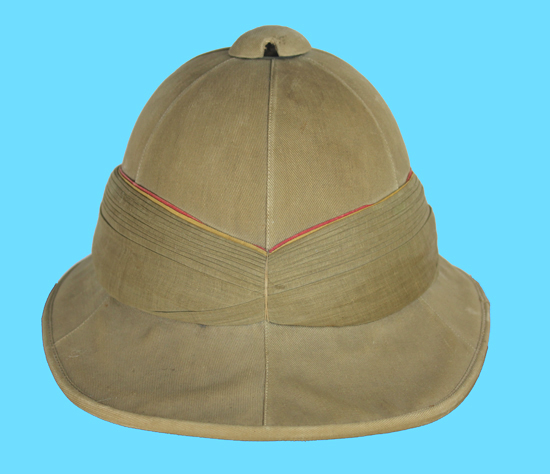
The rear fold of the Suffolk’s Wolseley aligned on the 12 o’clock seam – the front seam being the 6 o’clock position. (Author’s collection)
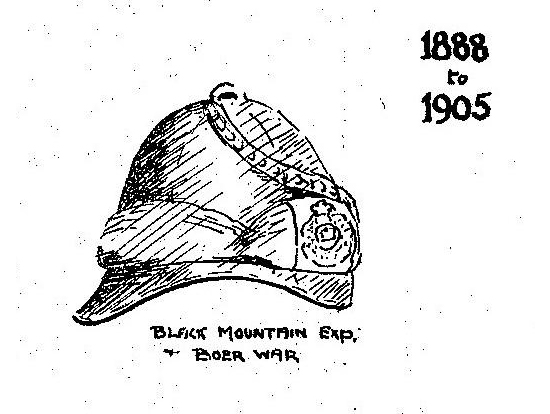
This illustration of a Colonial Pattern helmet to the Suffolk’s was the style worn between 1888 and 1905 i.e. the Black Mountain Expedition of 1888 and the adoption of the Wolseley helmet. (Courtesy of the Suffolk Regiment Museum)
According to Captain H.B. Monier-Williams, M.C., writing in 1937, the regiment adopted the triple fold puggaree about 1888 but he gives no precise date nor could he discern the origin of this style. 4
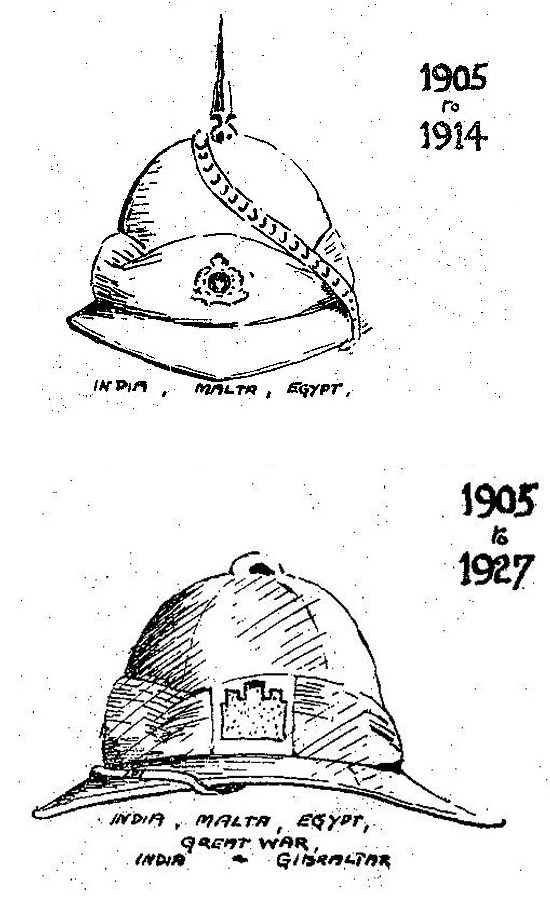
These illustrations show a white and khaki version of the Wolseley helmet to the Suffolk Regiment worn between 1905 and 1927. (Courtesy of the Suffolk Regiment Museum)
On the 3rd June 1905 the Wolseley helmet was issued to the 2nd Battalion, the Suffolk Regiment, in India. The puggaree was of twelve pleats in three folds. Officers also had a white version for ceremonial parades, but when parading with the men in khaki they wore the khaki helmet. 5 On the 9th March 1907, in accordance with A.G. India letter No. 801/A, the metal badge was discarded and a yellow cloth castle introduced and worn on the left hand side of the helmet. 6 Monier-Williams does not state when the 1st Battalion received their helmets but since they served overseas from 1907 (Malta) to 1927 (Gibraltar) it is safe to assume 1907.
The King’s Shropshire Light Infantry
This regiment had three folds to its puggaree: two on each side and one at the front. The folds were aligned to the 2, 6 and 10 o’clock seams in the helmet cover.
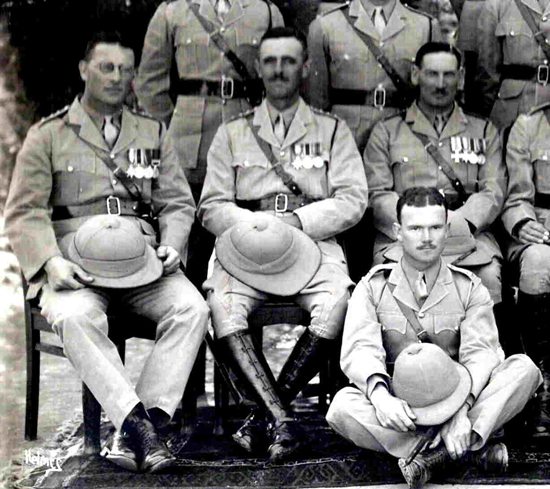
A group photograph of officers of the 1st Battalion, The King’s Shropshire Light Infantry, at Peshawar, India circa 1931. (Courtesy of the Shropshire Regimental Museum, Shrewsbury Castle)
This photograph clearly shows the puggaree folded in three places; at the front and the sides, lining up with the seams of the helmet. It is interesting to note that the officer seated on the ground does not have the green piping to his puggaree. This green piping was specified officially in the 1929 Clothing Regulations but according to John Mollo, “Photographs of the Regiment taken in Poona in 1925 show this green top [piping].” 7 It is also interesting that this officer’s helmet puggaree appears to have only the usual two folds and the author has two such KSLI examples in his collection – one with piping and one without.
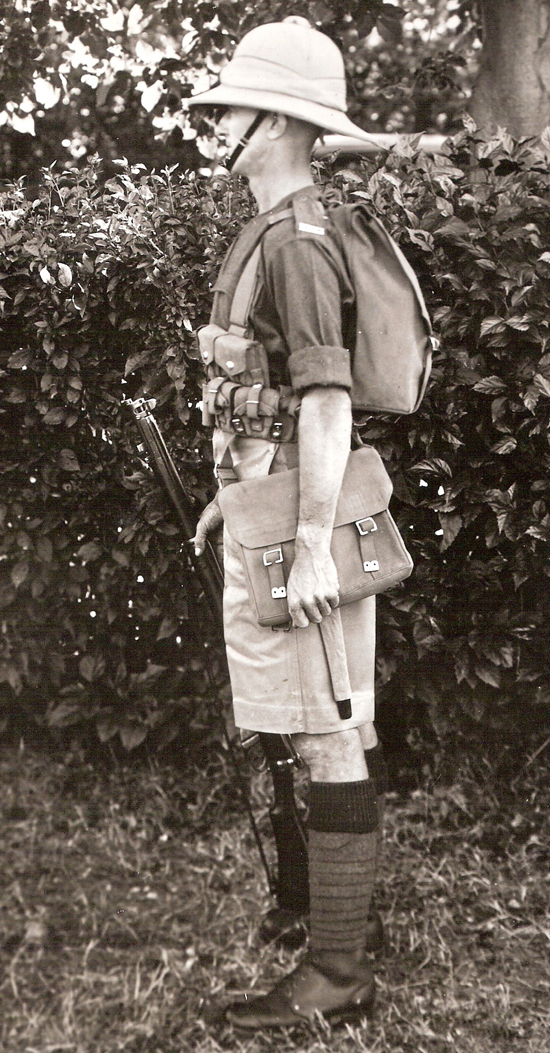
A private of The King’s Shropshire Light Infantry in India, early 1930s. (Courtesy of the Shropshire Regimental Museum, Shrewsbury Castle)
This splendid photo of a private in full marching kit, in India in the early 1930s, clearly shows the side fold and the front fold (indicated by the bulge.)
Four Fold Puggarees
The Cameronians (Scottish Rifles) * See last paragraph.
This regiment had four folds to its puggaree: one at the front, one on each side and one at the rear. The front and rear folds were aligned to the 6, and 12 o’clock seams respectively in the helmet cover. The side folds fell between the side seams or using the clock face nomenclature at 9 and 3 o’clock.
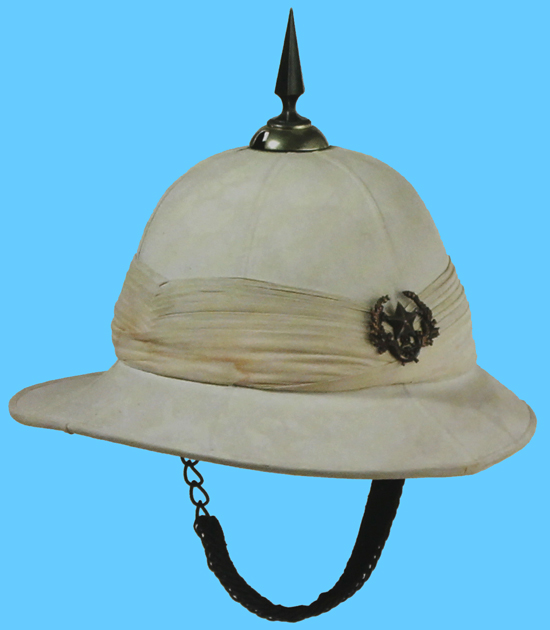
A Wolseley helmet to the Cameronians (Scottish Rifles) showing folds to the front and the right hand side of the helmet and which were repeated to the rear and the left hand side.
The above helmet 8 is attributed to Captain, later Major, John Collier Stormont-Darling who fought with the 2nd Battalion, the Cameronians (Scottish Rifles) in the Boer War. He was Mentioned In Despatches, awarded the Distinguished Service Order and was killed in action, by a sniper, on the 1st November 1916. 9
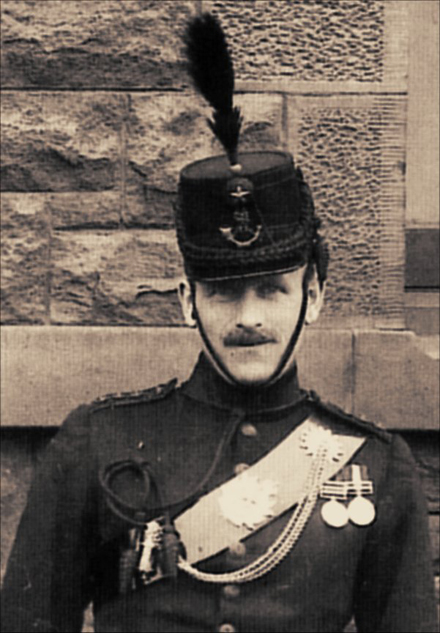
Captain John Collier Stormont-Darling in full dress c1905. His QSA and KSA medals are clearly shown. (Photo courtesy of Benny Bough)
* Information has just been provided, 3rd June 2012, that the Wolseley helmet shown above with the four fold puggaree is a “fake” in that the regiment never wore puggarees in such a fashion. This information was provided by an ex-curator of the Cameronians Museum who, regrettably has been ill and therefore, could not respond earlier.
The Cheshire Regiment
This regiment had four folds to its puggaree: one at the front, one on each side and one at the rear. The front and rear folds were aligned to the 6, and 12 o’clock seams respectively in the helmet cover. The side folds were aligned with the side seams at 9 and 3 o’clock. Note that the Khaki Sola Pith Hat, which officially replaced the Wolseley in 1937, had only four seams.
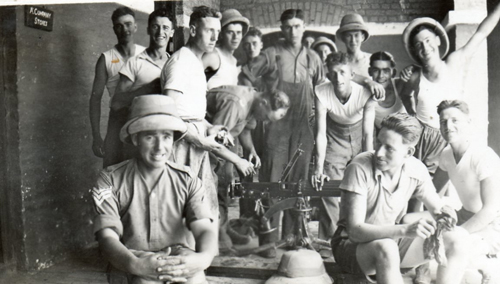
The Khaki Sola Pith Hat in the centre of this photograph of the 1st Battalion, the Cheshire Regiment, clearly shows the side fold in the puggaree. This photograph was taken whilst the regiment was stationed in Ambala, North West Frontier, in 1933. (Photo courtesy of David Rayner)
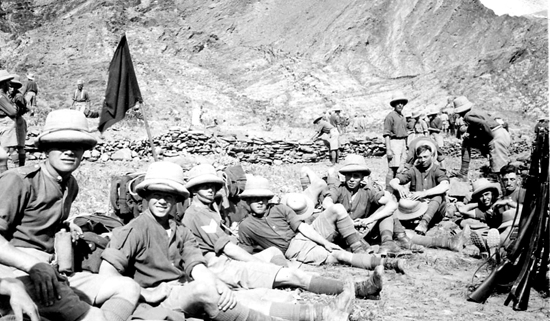
The Khaki Sola Pith Hat of the soldier seated to the right and rear of this photograph of the 1st Battalion, the Cheshire Regiment, clearly shows the side fold in the puggaree. This photograph was taken whilst the regiment was stationed in Ambala, North West Frontier, in 1933. (Photo courtesy of David Rayner)
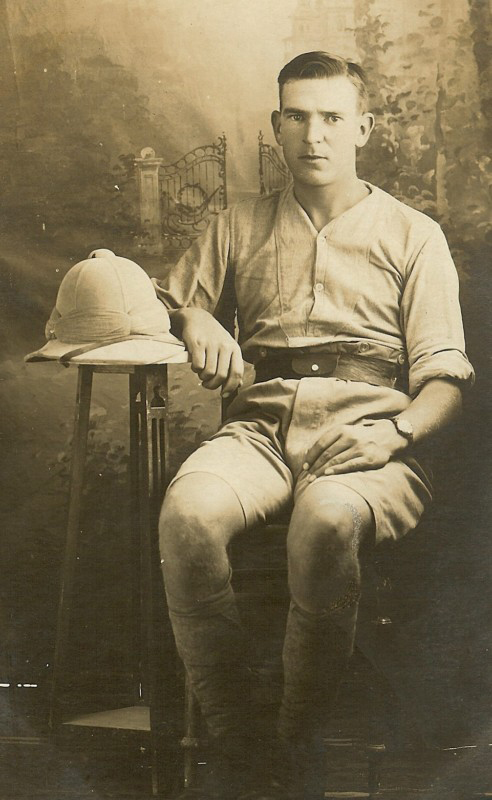
A soldier of the 1st Battalion, the Cheshire Regiment in India c1920s showing the four folds to the puggaree on his Wolseley helmet. (Author’s collection)
Note that the side folds do not align with the helmet seams but fall at 3 and 9 o’clock respectively.
The Leinster Regiment
This regiment had four folds to its puggaree: one at the front, one on each side and one at the rear. The front and rear folds were aligned to the 6, and 12 o’clock seams respectively in the helmet cover. The side folds were aligned with the side seams at 9 and 3 o’clock.
Six Fold Puggarees
The Highland Light Infantry
This regiment had six folds to its puggaree, aligned with the six seams of the helmet.
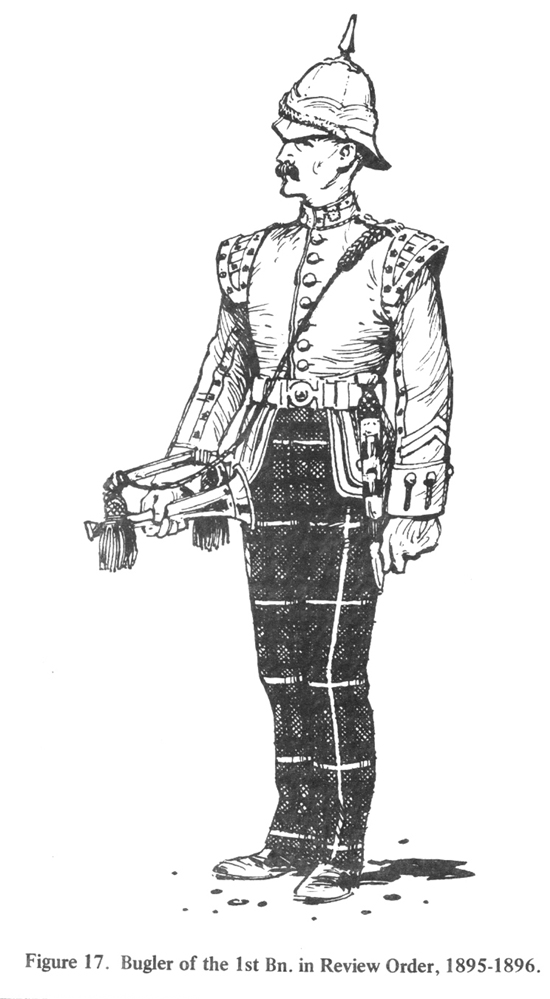
An illustration showing six folds to the puggaree of this bugler of the 1st Battalion the Highland Light Infantry. 10
“In 1895 the 1st Bn. left Aldershot and sailed for Malta. The shakos of the officers and men, and the feathered bonnets of the band were exchanged for white helmets. These had a brass spike and chain chin strap… officers and warrant officers having a loop at the back of the helmet to take the cap-lines previously worn with the shako. The pagri round the helmet was twisted 6 times (at each panel, front, back and sides) in a pattern peculiar to the regiment.” 11 The 2nd Battalion was overseas from 1884-1902 in India and Ceylon and it is unlikely that they would have used this style of puggaree. No further information is given as to the origin of this “peculiar” pattern, nor as to the dates within which it was worn.
The author would like to thank the curators of the Suffolk Regiment Museum (Mr. Gwyn Thomas) and the Shropshire Regimental Museum (Mr. Peter Duckers), Mr. David Rayner and Mr. Bernard Bough for their generous assistance. Not all regimental museums contacted by the author responded and therefore no assumption can be made that the five regiments in this article are the only regiments to have used an unusual puggaree arrangement.
Stuart Bates
1Roberts, Frederick Sleigh, Forty-one years in India, From Subaltern To Commander-In-Chief, MacMillan and Co.,1901
2Thackwell, Edward Joseph, Narrative of the Second Seikh War, in 1848-49, Richard Bentely, 1851
3Monier-Williams, Captain H.B., The Foreign Service Helmet, The Suffolk Regiment Gazette, Nov-Dec 1937
4Ibid.
5Ibid.
6Ibid.
7Mollo, John, The Formation Sign, The Military Heraldry Society, FS151, July, 1988
8Bosleys Auction Catalogue, Lot 861, 3rd June 2009
9In conversation with Benny Bough
10McKay & Anderson, The Highland Light Infantry, Uniforms of the Regiment 1881 to 1914, James B. McKay, Glasgow, 1977
11Ibid.

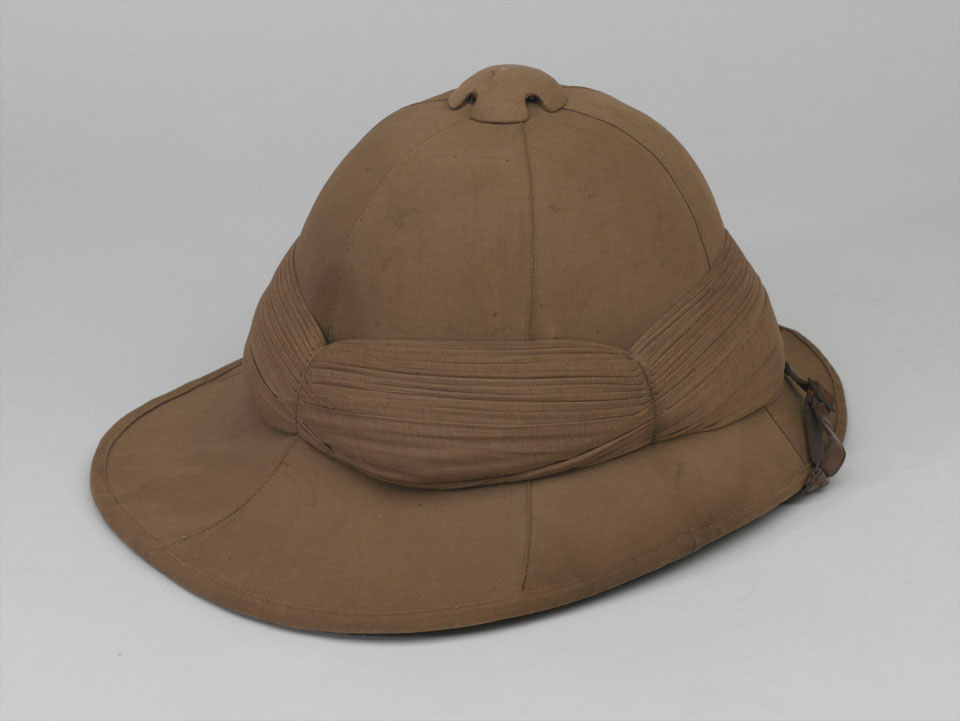
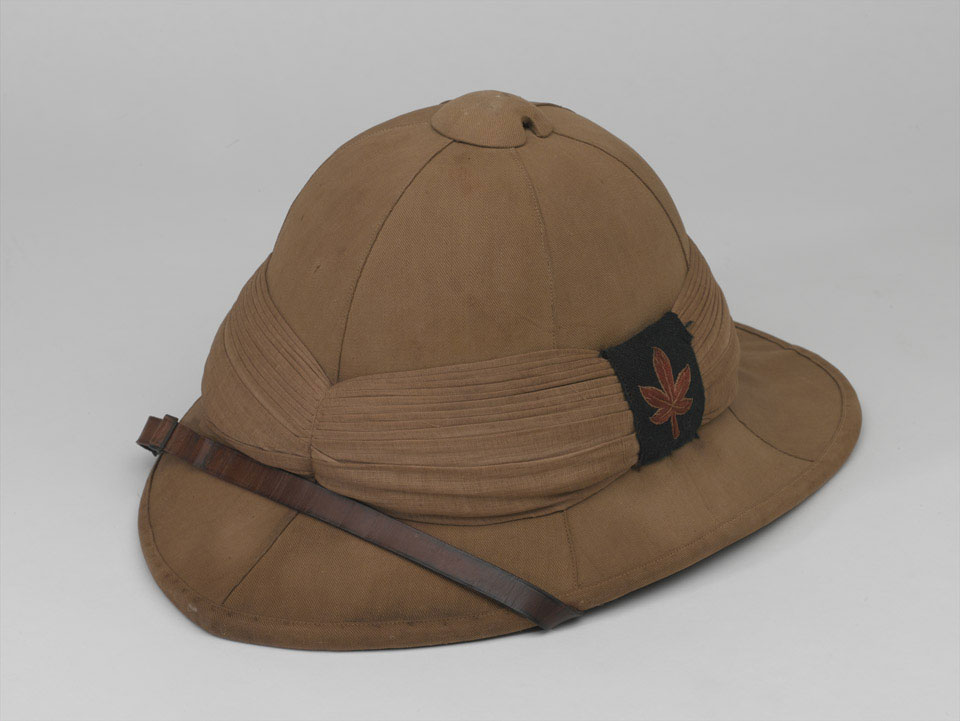
very interesting
You’re a mine of information Stuart…excellent article
How wide was the puggaree material?
Edwin,
I have just returned from a month’s holiday in Europe so apologies for the delay in responding.
The only example of a puggaree that I have, i.e. loose, is nearly 4″ wide and is folded 4 times to give a “fitted” width of about 1 1/2″. I do not doubt that the width varied from these dimensions over time and shall ask a friend who removed and refitted a puggaree.
Regards,
Stuart

Here is a photo of my loose puggaree.
I would be most interested to see any information anyone has regarding all aspects of Police uniform worn in India between 1930 and 47.
Will,
I shall ask a friend who has delved into the British police, mainly Staffordshire but police internationally. This is not my area but perhaps we can come up with some useful information.
Best regards,
Stuart
Great web site.
I am recreating an other ranks 4th bat cheshire regiment 1914-1918 khaki drill impression. Does anyone know if there was a flash on the helmet and if it changed by battalion or was standard for the regiment? John
I only have information on the 1st and 2nd battalions as follows “The 1929 Regulations give a ‘diamond patch 2″ x 2”, left half cerise, right half buff.’ This was replaced by a pom-pom in about 1929(?) which was worn until at least 1935. The 2nd Battalion did not wear the pom-pom.
The photos in this article of the Cheshires do not show patch nor pom-pom.
Stuart
Stuart
Many thanks for the reply. Given the variations I think a bit more digging is in order
john
Bravooo ! Très sympa Marine !!!!
I am trying to wrap a puggaree and was wondering what width twill tape to use for an authentic look. From looking at the pictures it is all over the place from about an inch to maybe as wide as two inches. Any advice?
Fred,
as shown above is my “loose” puggaree and dimensions. A friend refitted a puggaree to a Colonial Pattern helmet so I shall ask him.
Stuart
Fred,
here is what my friend had to say.
Yeah I can give them some good advice…don’t try it…it was a bloody frustrating thing to do. I wrapped and unwrapped mine at least half a dozen times. Keeping the pugaree tight was one of the hardest things to do, the nearer you get to the bottom, the slacker the top folds become… It’s one of those things that looks simple to do, and starts off feeling this is fairly easy with the first two or three folds and twists at the front and back, as you get to the bottom folds then it gets harder to keep everything tight and the twists front and back get harder and harder to keep looking level and tight, the oval shape of the crown has a tendency to make the pugaree ride over the previous folds at the front particularly, well I found that anyway. The last fold at the back when you tuck it under the bottom of the pugaree, to keep everything tight and in place is the make or break, and I realise now why I’ve seen pugarees with a small pin holding the end of the pugaree in place, trying to keep the pugaree taught and fold it under you need half a dozen hands, as soon as you let it go it looks ok, but the bottom fold becomes slack after a couple of minutes. I tried making the pugaree several widths, what I found was the wider I made it, it seemed easier to keep the twists from riding up at the bottom, as I said, it was frustrating to do, it’s just a case of trial and error until you get it right.
Stuart
Thanks. I will keep trying. I have used a hot glue gun to tack the wraps down on each wrap. This made it a little easier to keep it tight as the next level was started. I was using 5/8 cotton twill tape which is just too narrow and does not have an authentic look.
To finish it off I cut the twill at an angle and glued it down vice trying to tuck it under. I will unwrap it all and try again with 1 or 1 1/2 inch wide cotton twill tape.
somebody may be interested to know that the tall,balding soldier bending over the vickers gun in the first of the cheshire regiment photographs is john(“jack”)mccoll,my father,who did his ww11service back in india again…. calcutta,as an aa wireless operator.he was then with 21st(city of london)anti aircraft regiment.he died in liverpool in 1983.he liked the army,i think,and came through it all with only one minor wound.
Hi Brian,
It is information like this that personalises and therefore enhances our efforts with our articles.
My late father also “enjoyed” his time in the British Army in the sense of the camaradie which so often kept them going.
Thank you,
Stuart
thank you,stuart,it is up to us to ensure that nothing good is ever lost. brian.
Actually, a query. I’m researching The Queen’s Own Corps of Guides, Punjab Frontier Force. I’m especially interested in the time from the Second Afghan War to the turn of the century. I’ve seen representations of the puggaree in both khaki and red AND in a patterned puggaree of yellows and light blues. Was there any official coloration for the unit? Any particular or unusual folds? Are there extant examples of QOCGs helmets with puggarees?
Thanks
Frank Coffman
Hi Frank,
I don’t have much material on the Corps of Guides and that mainly photos. These show a variety of puggaree patterns. At one stage a turban style seems to have been in vogue with vertical stripes and no folds. Others with two folds and others seemingly a simple band.
There is an excellent photo of officers showing this variety taken in 1897 and others taken in 1878 and 1903.
I have never seen a helmet for sale nor any in collections.
Regards,
Stuart
I am currently re-enacting 2nd battalion kings Shropshire light infantry 1938 -39 when stationed in the west indies tropical uniform with pith helmets were issued have you any other information regards puggaree and unit badges on side of helmet
Hi David,
as far as my information goes they wore a khaki patch 1½” square on the left hand side embroidered with a dark green bugle horn and KSLI in old gold.
Stuart
I should think that the fabric was first wetted, and quite possibly cut on the bias. When the fabric dried, it would then tighten and tauten up. The helmet being pith and fabric, probably pins were used during the layup so fold angles of successive layers would line up vertically.